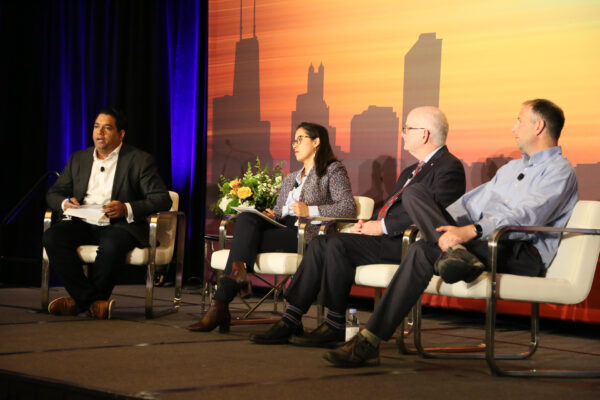
From left, Veneeth Iyengar, executive director of broadband development and connectivity for the state of Louisiana, moderates a panel on health disparities with Dianne Munevar, senior director of business ventures and innovation at NORC at the University of Chicago; Kevin B. Mahoney, CEO of the University of Pennsylvania Health System; and Dr. Michael Hochman, CEO of Healthcare in Action Medical Group.
In a panel Wednesday at MedCity INVEST in Chicago, experts tackled key components to improving health equity.
Among those, panelists talked about the need to engage whole communities, not just individual patients, and how improved internet connectivity could help address social determinants of health. The conversation centered, in part, on expanding infrastructure and internet access in less populated areas. This was viewed as a foundation, though not a panacea, for targeting inequities in care.

With the Rise of AI, What IP Disputes in Healthcare Are Likely to Emerge?
Munck Wilson Mandala Partner Greg Howison shared his perspective on some of the legal ramifications around AI, IP, connected devices and the data they generate, in response to emailed questions.
“I think there’s a lot we can do on the digital divide once we get broadband out,” said Kevin B. Mahoney, CEO of the University of Pennsylvania Health System.
Certainly, there’s significant investment being made to accomplish just that, and there’s an emphasis on expanding broadband sooner rather than later.
To recap: $65 billion is going to be spent on addressing the digital divide in the U.S., said panel moderator Veneeth Iyengar, who is the executive director of broadband development and connectivity for the state of Louisiana. In that role, he’s overseeing an investment of between $1.8 billion and $2 billion to improve internet connectivity; it’s money that must be spent over the next five years.
“So we’re not talking about a 20-year effort but a five-year effort to substantially bridge the digital divide in Louisiana,” Iyengar emphasized.
At present, about about 1.6 million of the 4.6 million people living in the state do not have access to the internet, he said. Those without access, don’t have devices they can use to get online or broadband access.
In an increasingly connected world, not having a mobile device or home internet access can make it harder to meet basic needs. It can be difficult to address social determinants of health, like if someone lacks transportation, without that connection, said Dianne Munevar, senior director of business ventures and innovation at NORC at the University of Chicago.
Most people can’t just hail a cab. Instead, they might use Uber or Lyft, which has a healthcare arm—and in order to access that transportation, you need access to the internet, Munevar said.
But expanding broadband alone won’t fix everything, panelists said.
“Broadband is incredibly important but not sufficient if we really care about health equity,” said Dr. Michael Hochman, a primary care physician who cares for people who are homeless as CEO of Healthcare in Action Medical Group, which is based on Long Beach, California.
Where giving everyone the latest smartphone could be costly and unsustainable, panelists discussed the need for affordable, accessible mobile devices people could use to connect with services they can only access online.
But the panel didn’t rule out offline solutions entirely. For example, Iyengar mentioned that it is important to be familiar with a community’s anchors, like non-medical facilities where people frequent or gather. In some instances, for instance, library rooms are being used for telehealth, he noted.
Additionally, a person who doesn’t have a doctor nearby may have ready access to a pharmacy, which can provide some basic health services. Pharmacies have been a boon during the pandemic, as the place hundreds of millions have gotten Covid-19 vaccinations.
“I think there’s tremendous opportunity to innovate and use that touch point … to connect with patients,” Hochman said.
Photo: Walter Lim, MedCity News














